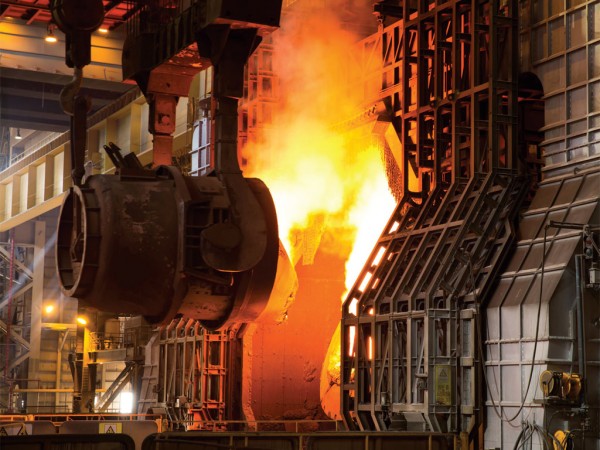Page 1: Manufacturing Recession
Page 2: Falling Demand
Demand, production, and share prices are all down; layoffs are on their way up
A superficial reading of United States steel industry statistics could tend to bear out President Donald Trump’s trade policy. Through August 2019, U.S. imports of steel decreased 13.4% on the year in terms of tonnage and 15.7% in terms of value. In August 2019, the steel trade deficit was 42.7% lower than the year before.
Year-to-date production as of early November was up by 2.5% from the same period last year for the domestic industry, and the capability utilization rate stood at 80.3%—up 2.4% from 2018 when the year-to-date utilization rate was 78.1%. (See Steel by the Numbers.)

But other numbers tell a different story. Output by U.S. mills began to decline in early November, as did the average mill utilization rate. In September, U.S. mills saw a decrease in domestic shipments of over 700,000 compared to the month before as well as a small decline in total exports. Steel import permit applications in October increased by 29.2%.
Manufacturing Recession
There has been much talk about whether the U.S. is experiencing a manufacturing recession, all of which may be beside the point since there is no accepted definition of what constitutes a recession in a particular industry. It is clear, however, that Trump’s trade war has led to a global trade slump and, in turn, slowdowns in manufacturing and in capital spending by U.S. businesses.
Manufacturing output in the U.S. is down 0.9% in the past year, while factory shipments are down 0.4% year-on-year according to the Census Bureau. These numbers are not as severe as those experienced during the 2008 recession or even the 2015-2016 manufacturing slump, but they do indicate a downturn. So, does the plunge in the Institute for Supply Management’s manufacturing index, which fell from 60.8 in August 2018 to a 10-year low of 47.8 in September.
The steel industry, domestically and worldwide, are bearing the brunt of these trends, as are the workers employed in that sector. The most recent U.S. jobs report beat expectations, but held some ominous import for manufacturing workers, with a decline in hours worked. In the steel sector, lower demand and production cutbacks have meant layoffs at several steel companies this year.
As a case in point, the Luxembourg-based ArcelorMittal, the largest steelmaker in the world, recently reported its second quarterly loss in a row—a third-quarter deficit of $539 million, compared to a profit of $899 million in last year’s third quarter. The company blamed lower shipments and weak steel prices in markets all over the world. (Some U.S. steelmakers are still reporting profits. See Steel by the Numbers)
For the nine months ending September 30, ArcelorMittal reported a decrease of 1.8% in total steel shipments compared to the same period last year. The company expects steel consumption in the U.S. to contract by one percent due to ongoing weakness in automotive demand and a slowdown in the machinery sector. Cost cutting may have motivated ArcelorMittal to announce the recent shutdown of one of the three blast furnaces at its Indiana Harbor steelmaking plant in East Chicago, Indiana.
ArcelorMittal isn’t the only steelmaker shutting down production capacity and laying off employees. Lower demand and lower production are now bearing their fruit, in the form of job cuts at major steel producers in the United States over the past few months.
AK Steel announced the closing of its mill in Ashland, Kentucky, by the end of the year, throwing 260 employees out of work. Earlier this year, TMK Ipsco Tubulars Inc. announced it was laying off 159 workers at its plant in Wilder, Kentucky, due to dropping demand from the oil and gas industry.
NLMK steel in Farrell, Pennsylvania, which imports steel slabs from Russia and rolls them into finished products, laid off 100 workers in its hot mill over the summer, citing the higher costs of steel imports. In October, United Structures of America closed its plant in Portland, Tennessee, putting 45 employees out of work. The company blamed the layoffs on falling demand for steel in the construction industry.
Barber Steel Foundry in Rothbury, Michigan, part of the Pittsburgh-based Wabtec (Westinghouse Air Brakes Technology) Corporation, which manufactures locomotives and freight cars, is closing this month, laying off 61 employees. Bayou Steel in Louisiana filed for bankruptcy October 1 and announced it was closing, putting 439 people out of work, including 72 workers at its Harriman, Tennessee, operations.
Earlier this year, United States Steel (USS), the second largest steel producer in the U.S., shut down one of its blast furnaces at its Great Lakes Works near Detroit, cutting 250 jobs through September. USS also announced it is idling its tin mill in East Chicago, Indiana, laying off some 300 workers.

Follow us on social media: